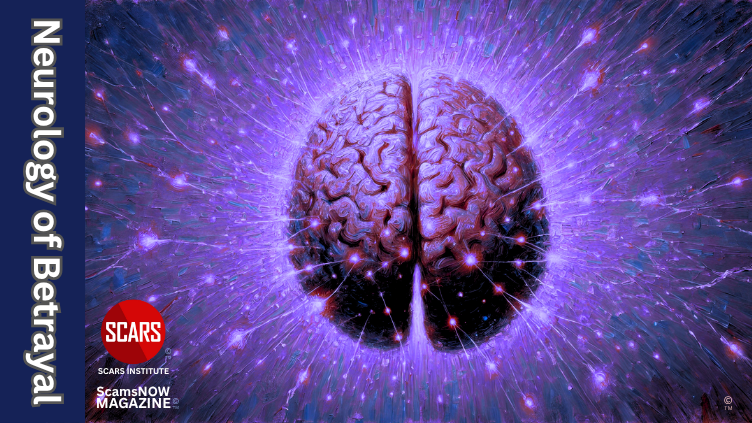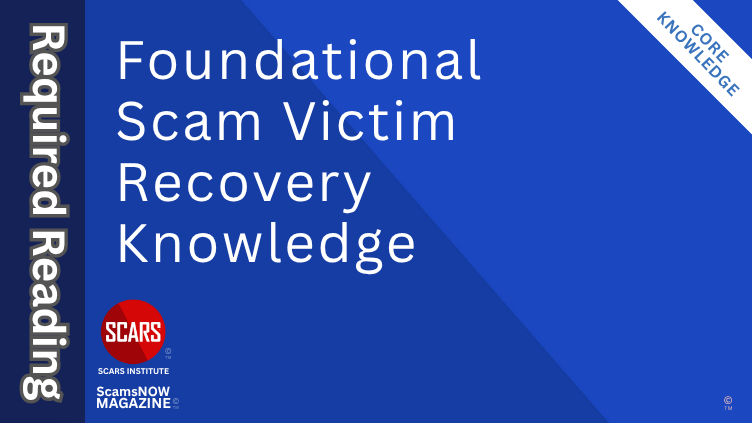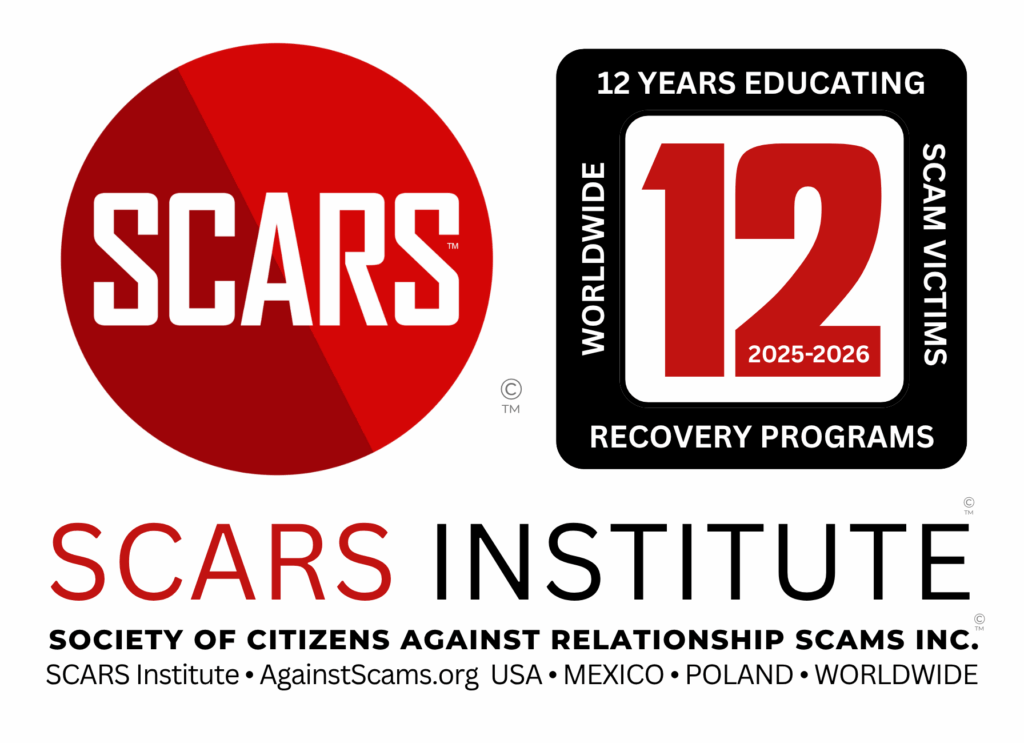
Neurology of Betrayal
From Emotional Surges to Neurotransmitter Addiction and How to Regain Control Again
Primary Category: Neurology / Psychology
Authors:
• Vianey Gonzalez B.Sc(Psych) – Licensed Psychologist, Specialty in Crime Victim Trauma Therapy, Neuropsychologist, Certified Deception Professional, Psychology Advisory Panel & Director of the Society of Citizens Against Relationship Scams Inc.
• Tim McGuinness, Ph.D., DFin, MCPO, MAnth – Anthropologist, Scientist, Polymath, Director of the Society of Citizens Against Relationship Scams Inc.
Author Biographies Below
About This Article
From a neurological perspective, a clear picture emerges of how betrayal trauma affects the brain and body. Intense alarms in the amygdala spark cortisol and adrenaline, while disrupted dopamine, serotonin, and oxytocin patterns create emotional surges that can become habit forming. Within the 90-second window after a trigger, feelings peak and can fade if new thoughts do not refuel them, which opens space for calm choices. Reinforced rumination extends the surge and can resemble dependency. Practical supports include mindfulness to notice and release waves, cognitive behavioral tools to reframe predictions, and neurofeedback to improve self-regulation. Steady habits such as sleep, movement, and balanced nutrition, along with creative expression, self-compassion, and time in nature, help restore emotional balance. With a simple plan that pairs brief pauses with verification of thoughts, survivors can reduce hijacks, rebuild stability, and move recovery forward.
Note: This article is intended for informational purposes and does not replace professional medical advice. If you are experiencing distress, please consult a qualified mental health professional.

Navigating the Neurobiology of Betrayal: From Amygdala Hijacks and Emotional Surges to Neurotransmitter Addiction
Betrayal trauma, particularly from relationship scams, can leave individuals feeling shattered and adrift in a sea of conflicting emotions. Understanding the neurobiological underpinnings of these experiences can provide a roadmap for healing and resilience. This article delves into the intricate relationship between emotional responses, neurotransmitter addiction, and the concept of the 90-Second Rule, offering insights and strategies for those navigating the aftermath of betrayal.
The Neuroscience of Betrayal
Betrayal trauma triggers a cascade of neurobiological responses that can be both overwhelming and addictive. When a person experiences betrayal, the brain’s emotional centers, particularly the amygdala, become hyperactivated. The amygdala is responsible for processing emotional responses, especially those related to fear, anxiety, and social pain. This activation leads to the release of stress hormones such as cortisol and adrenaline, preparing the body for a “fight or flight” response.
The Amygdala’s Role in Emotional Hijacking
The amygdala’s hyperactivation can result in what is known as “emotional hijacking,” or “amygdala hijacking,” where the rational parts of the brain, such as the prefrontal cortex, are temporarily overwhelmed. This hijacking can cause intense emotional reactions that are disproportionate to the situation, leading to a state of chronic stress and anxiety. Over time, this pattern can create a feedback loop where the individual becomes addicted to the emotional response itself, seeking out situations or thoughts that replicate the initial betrayal.
Emotional hijacking is a phenomenon that can have profound and lasting effects on an individual’s emotional and psychological well-being. When the amygdala takes control, it can lead to a range of intense and often irrational responses. For instance, a person might experience an overwhelming sense of fear or anger that seems to come out of nowhere, triggered by a seemingly innocuous event. This response is not a choice but a reflex, a survival mechanism that has been honed over millennia to ensure our ancestors’ safety in the face of danger.
In the context of betrayal trauma, emotional hijacking can manifest in various ways. A person might find themselves reliving the moment of betrayal over and over again, each time experiencing the same surge of emotions as if it were happening for the first time. This repetition can reinforce the neural pathways associated with the traumatic event, making it increasingly difficult to break free from the cycle of emotional distress.
Moreover, emotional hijacking can affect not only the individual’s emotional state but also their cognitive functioning. The prefrontal cortex, which is responsible for executive functions such as decision-making, impulse control, and logical reasoning, becomes less active during an amygdala hijack. This can lead to impulsive behaviors and decisions that, in retrospect, may seem irrational or counterproductive. For someone recovering from betrayal, this can mean acting out in ways that further complicate their emotional and social landscape.
Neurotransmitter and Hormonal Responses
During emotional hijacking, the brain releases a cocktail of neurotransmitters and hormones that create a powerful physiological and psychological response. Neurotransmitters such as dopamine, serotonin, and oxytocin, which are associated with reward, pleasure, and social bonding, can become dysregulated. This dysregulation can lead to a state of neurochemical imbalance, where the brain becomes dependent on the surge of these chemicals to feel a sense of normalcy or relief.
The neurochemical cascade triggered by betrayal can be particularly insidious. Dopamine, often referred to as the “reward neurotransmitter,” is released in anticipation of or in response to pleasurable experiences. In the context of a betrayal, the brain may have become conditioned to associate certain stimuli with the reward of emotional connection and intimacy. When this connection is severed, the absence of dopamine can lead to a sense of withdrawal and craving, similar to that experienced in substance addiction.
Serotonin, another key neurotransmitter, plays a crucial role in mood regulation, appetite, and sleep. Betrayal can disrupt serotonin levels, leading to symptoms of depression and anxiety. The brain’s attempt to compensate for this disruption can result in a cycle of emotional highs and lows, as it struggles to reestablish a stable baseline. This instability can make it difficult for individuals to maintain a sense of emotional equilibrium, further exacerbating their distress.
Oxytocin, often called the “love hormone” or “cuddle hormone,” is released during moments of social bonding and intimacy. In the aftermath of betrayal, the absence of oxytocin can leave individuals feeling disconnected and isolated. The brain may seek to replenish this deficit by engaging in behaviors that mimic the conditions under which oxytocin is naturally released, such as seeking out new romantic connections or engaging in social activities that provide a sense of belonging.
The 90-Second Rule: A Window of Opportunity
The 90-Second Rule, proposed by neuroscientist Dr. Jill Bolte Taylor, suggests that the initial physiological response to an emotional trigger lasts approximately 90 seconds. During this time, the brain and body are flooded with specific neurotransmitters and hormones. If the emotional response is not reinforced by additional thoughts or stimuli, it should naturally subside after 90 seconds. This rule provides a crucial window of opportunity for individuals to observe and manage their emotional responses without becoming overwhelmed by them.
Understanding the 90-Second Window
Within this 90-second window, individuals have the chance to acknowledge their emotions without judgment and allow them to pass naturally. This mindfulness can help break the cycle of reinforcement that sustains continued triggering and emotional addiction. For example, someone who experiences a surge of anger or sadness can use this time to take deep breaths, practice grounding techniques, or engage in a brief meditation to regulate their emotional response; they can pass through that 90 seconds and be over it.
The 90-Second Rule is a powerful concept that can be transformative for those struggling with emotional regulation. By recognizing that the initial surge of emotions is a temporary physiological response, individuals can learn to observe these feelings without becoming entangled in them. This observation allows for a moment of clarity, a pause in the otherwise relentless cycle of emotional reactivity.
During this window, the brain is in a state of heightened awareness, with the amygdala’s alarm bells ringing loudly. However, the prefrontal cortex, which is responsible for rational thought and decision-making, is still online and capable of intervening. By engaging in simple, calming activities such as deep breathing or progressive muscle relaxation, individuals can signal to their brain that the threat has passed, allowing the emotional storm to dissipate.
Additionally, the 90-Second Rule emphasizes the importance of non-judgmental awareness. When individuals can acknowledge their emotions without labeling them as “good” or “bad,” they create space for these feelings to exist and eventually fade away. This acceptance is a key component of mindfulness practices and can be particularly beneficial for those recovering from betrayal, as it allows them to process their emotions without becoming overwhelmed by them.
Reinforcement and Dependency
However, the 90-Second Rule also highlights the potential for negative reinforcement and dependency. If the emotional response is reinforced by continued focus on the triggering event or thought pattern, the neurochemical surge can be prolonged and intensified. This reinforcement can lead to a state of neurotransmitter addiction, where the brain becomes dependent on the external stimulus to produce these feelings.
Reinforcement and dependency are central to the development of emotional addiction. When the brain experiences a surge of neurotransmitters and hormones in response to an emotional trigger, it creates a powerful association between the stimulus and the pleasurable or relieving feelings that follow. This association can become so strong that the mere thought of the stimulus can trigger the release of these chemicals, reinforcing the addictive behavior. Scammers know how to exploit this and reinforce neurotransmitter and hormonal addiction as a control mechanism, but after the scam ends, these impulses can continue.
For instance, a person who has experienced betrayal might find themselves constantly replaying the events in their mind, each time experiencing a fresh surge of emotions. This mental replay can reinforce the neural pathways associated with the traumatic event, making it increasingly difficult to break free from the cycle of emotional distress. Over time, the brain may become dependent on this emotional rollercoaster, seeking out situations or thoughts that replicate the initial betrayal to experience the familiar, albeit painful, neurochemical surge. Though for most victims/survivors, the addictive phase after the scam ends is over in a few weeks.
Furthermore, the reinforcement of emotional responses can lead to a form of behavioral addiction, where individuals engage in specific behaviors or thought patterns to recapture the emotional high or low. This can include such addictions as rage, sex, thrill-seeking, and many more. In scam victims, this can manifest as obsessive rumination, where a person repeatedly goes over the details of the betrayal, or as a compulsive need to seek out information about the person who caused the betrayal. These behaviors provide a sense of control and familiarity, even if they are ultimately harmful to the individual’s emotional well-being.
Breaking the Cycle of Neurotransmitter Addiction
Managing neurotransmitter addiction involves a multifaceted approach that combines awareness, mindfulness, and strategic interventions. By understanding the mechanisms of emotional hijacking and the 90-Second Rule, individuals can develop strategies to regain control over their emotional well-being.
Mindfulness and Emotion Regulation
Mindfulness practices, such as meditation and deep breathing, can help individuals observe their emotional responses without judgment. We have many articles about mindfulness and related activities here in ScamsNOW.com
By becoming aware of the thoughts and sensations that trigger emotional hijacking, people can learn to interrupt the cycle and choose a different response. Mindfulness-based stress reduction (MBSR) and mindfulness-based cognitive therapy (MBCT) are effective approaches that combine mindfulness with cognitive-behavioral techniques to manage emotional responses and reduce the intensity of emotional hijacking.
Mindfulness is a powerful tool for emotion regulation, offering a non-judgmental space in which to observe and understand one’s emotional landscape. By cultivating mindfulness, individuals can develop a greater awareness of the physical sensations, thoughts, and emotions that arise in response to triggers. This awareness allows them to step back from their reactions and choose how to respond, rather than being swept away by the tide of emotion.
Practicing mindfulness can take many forms, from formal meditation sessions to informal moments of present-moment awareness throughout the day. For those recovering from betrayal, mindfulness can provide a sanctuary from the whirlwind of emotions, offering a chance to pause, breathe, and respond with greater clarity and compassion. Techniques such as body scanning, where individuals mentally scan their body from head to toe, can help them become more attuned to the physical sensations that accompany emotional states, providing a grounding anchor in the present moment.
Moreover, mindfulness can enhance emotional resilience by fostering a sense of acceptance and non-reactivity. When individuals can acknowledge their emotions without trying to change or suppress them, they create space for these feelings to exist and eventually dissipate. This acceptance is a key component of emotional regulation and can be particularly beneficial for those struggling with the aftermath of betrayal, as it allows them to process their emotions without becoming consumed by them.
Cognitive Behavioral Therapy (CBT)
Cognitive Behavioral Therapy (CBT) is a powerful tool for identifying and changing the thought patterns that contribute to emotional addiction. By challenging and reframing negative or anxious thoughts, individuals can reduce the frequency and intensity of emotional hijacking. CBT techniques, such as cognitive restructuring and exposure therapy, can help individuals develop a more balanced and resilient mindset, making it easier to manage the emotional fallout of betrayal.
CBT is rooted in the understanding that our thoughts, feelings, and behaviors are interconnected, and that by changing our thoughts, we can influence our emotions and actions. For someone recovering from betrayal, CBT can provide a structured approach to identifying and challenging the negative thought patterns that may be reinforcing their emotional distress. This might involve recognizing and disputing thoughts such as “I will never trust anyone again” or “This betrayal defines me as a person”.
Cognitive restructuring, a key component of CBT, involves identifying distorted or unhelpful thought patterns and replacing them with more balanced and realistic alternatives. For example, a person might challenge the thought “I am unlovable because I was betrayed” with a more nuanced perspective, such as “Being betrayed does not reflect on my worth as a person; it reflects on the actions of the betrayer.” This shift in thinking can help reduce the emotional intensity associated with the betrayal and promote a more compassionate self-view.
Exposure therapy, another CBT technique, can be particularly useful for addressing the anxiety and avoidance behaviors that often accompany betrayal trauma. By gradually and safely exposing individuals to the situations or thoughts that trigger their emotional responses, they can learn to manage their reactions and reduce the power of these triggers over time. This might involve writing about the betrayal, imagining future social interactions, or role-playing conversations with the person who caused the betrayal, all in a safe and controlled environment.
Neurofeedback and Brain Training
Neurofeedback is a non-invasive technique that involves training the brain to self-regulate by providing real-time feedback on brain activity. This approach can help individuals gain control over their emotional responses and reduce the intensity of emotional hijacking. By learning to modulate their brain waves, individuals can develop greater emotional stability and resilience, making it easier to navigate the challenges of betrayal trauma.
Neurofeedback operates on the principle that the brain is a dynamic and adaptable organ, capable of learning and changing in response to feedback. During a neurofeedback session, individuals are connected to sensors that monitor their brain activity, typically through electroencephalography (EEG). This activity is then translated into visual or auditory feedback, allowing the individual to see or hear their brain waves in real-time. By focusing on specific patterns or frequencies, individuals can learn to self-regulate their brain activity, enhancing their ability to manage emotional responses.
For someone recovering from betrayal, neurofeedback can provide a unique opportunity to retrain their brain’s emotional regulation systems. By identifying and targeting the specific brain wave patterns associated with emotional hijacking, individuals can learn to interrupt these patterns and restore a sense of calm and control. This might involve increasing alpha waves, which are associated with relaxation and reduced anxiety, or decreasing beta waves, which are often elevated during states of stress and agitation.
Moreover, neurofeedback can be tailored to address the unique needs and challenges of each individual. For example, some protocols may focus on enhancing the activity of the prefrontal cortex, which plays a crucial role in emotional regulation and decision-making. Others may target the amygdala, aiming to reduce its hyperactivity and the intensity of emotional responses. By personalizing the neurofeedback training, individuals can develop a more nuanced and effective approach to managing their emotional well-being.
There are many neurofeedback devices on the market; however, they are not inexpensive, at least the real ones. Talk to your therapist about neurofeedback and how you can make it an effective part of your therapy and recovery.
Lifestyle Changes and Holistic Approaches
Regular exercise, a healthy diet, and adequate sleep can support overall brain health and reduce the likelihood of emotional hijacking. These lifestyle factors can help regulate neurotransmitter and hormonal balance, making it easier to manage emotional responses. Additionally, holistic approaches such as yoga, tai chi, and acupuncture can complement traditional therapies by promoting relaxation, reducing stress, and enhancing overall well-being.
Lifestyle changes can have a profound impact on emotional regulation and resilience. Exercise, for instance, is a powerful tool for managing stress and improving mood. Physical activity stimulates the release of endorphins, often referred to as “feel-good” hormones, which can counteract the effects of stress and promote a sense of well-being. For someone recovering from betrayal, engaging in regular exercise can provide a healthy outlet for emotional energy and a sense of accomplishment and empowerment.
A healthy diet is equally important in supporting emotional well-being. Nutrients such as omega-3 fatty acids, found in foods like fish, nuts, and seeds, play a crucial role in brain health and can help regulate mood and reduce symptoms of depression and anxiety. Similarly, a diet rich in antioxidants, vitamins, and minerals can support overall brain function and resilience, making it easier to manage the emotional challenges of betrayal trauma.
Adequate sleep is another cornerstone of emotional health. During sleep, the brain undergoes essential processes of repair and consolidation, including the regulation of neurotransmitters and hormones. Chronic sleep deprivation can disrupt these processes, leading to increased emotional reactivity and a reduced ability to cope with stress. For individuals recovering from betrayal, prioritizing good sleep hygiene can enhance their emotional stability and resilience, providing a foundation for healing and growth.
Holistic approaches, such as yoga and tai chi, offer additional benefits for emotional regulation and stress reduction. These practices combine physical movement with breath control and meditation, promoting a state of calm and present-moment awareness. Yoga, in particular, has been shown to reduce cortisol levels, the body’s primary stress hormone, and increase the production of GABA, a neurotransmitter that helps regulate mood and anxiety. Tai chi, with its slow and deliberate movements, can also promote relaxation and emotional balance, making it a valuable complement to more traditional therapeutic approaches.
Acupuncture, an ancient healing practice, may also play a role in managing the emotional fallout of betrayal. By stimulating specific points on the body, acupuncture may help regulate the flow of energy and promote healing. For some individuals, acupuncture may provide relief from symptoms of stress, anxiety, and depression, offering a non-pharmacological approach to emotional well-being.
Strategies for Healing and Resilience
Healing from betrayal trauma requires a comprehensive and individualized approach that addresses both the emotional and neurobiological aspects of the experience. Here are some strategies that can support the journey toward healing and resilience:
Building a Support Network
A strong support network can provide emotional validation, practical assistance, and a sense of belonging during the healing process. Connecting with friends, family, support groups, or therapists can offer a safe space to express emotions, share experiences, and gain insights from others who have navigated similar challenges. This social support can help regulate neurotransmitter levels and promote a sense of security and stability.
Building a support network is a crucial step in the healing journey, as it provides a safety net of understanding and empathy. Friends and family can offer a listening ear, a shoulder to lean on, and a reminder that one is not alone in their struggle. Support groups, whether in-person or online, can be particularly beneficial, as they connect individuals with others who have experienced similar traumas. These groups provide a space to share stories, offer advice, and find comfort in the collective experience of healing. Caution: Avoid groups that obsess over identifying the scammers and exposing stolen photos; these will not be beneficial to your recovery.
Therapists and counselors play an essential role in the support network, offering professional guidance and a structured approach to healing. They can provide tools and techniques for managing emotions, processing trauma, and rebuilding self-esteem. Moreover, therapists can help individuals develop a deeper understanding of their emotional responses and the neurobiological underpinnings of their experiences, empowering them to take an active role in their healing journey.
Engaging in Creative Outlets
Creative activities, such as journaling, painting, or playing music, can serve as therapeutic outlets for processing emotions and reducing stress. Engaging in creative pursuits can activate the brain’s reward centers, releasing neurotransmitters such as dopamine and serotonin, which can counteract the effects of stress and promote a sense of well-being. Creative expression can also provide a non-verbal means of exploring and communicating complex emotions, facilitating the healing process.
Creative outlets offer a unique avenue for emotional expression and processing, allowing individuals to explore and communicate their feelings in ways that words alone cannot capture. Journaling, for instance, can be a powerful tool for self-reflection and emotional release. By putting thoughts and feelings onto paper, individuals can gain clarity and perspective and begin to make sense of their experiences. This process can also help identify patterns and triggers, providing valuable insights for emotional regulation and healing.
Visual arts, such as painting or drawing, can provide a similar outlet for emotional expression. The act of creating art can be meditative and therapeutic, allowing individuals to channel their emotions into something tangible and beautiful. For some, the colors and shapes they choose may reflect their inner emotional landscape, offering a visual representation of their feelings and a means of exploring them more deeply.
Music and performance arts can also play a significant role in the healing process. Playing an instrument or singing can activate the brain’s reward centers, releasing endorphins and promoting a sense of accomplishment and joy. Additionally, performing in front of others can boost self-esteem and provide a sense of connection and belonging, as individuals share their artistic expression with an audience 127,128,129.
Practicing Self-Compassion
Self-compassion involves treating oneself with kindness, understanding, and support during difficult times. Practicing self-compassion can help reduce self-criticism and promote emotional resilience. Techniques such as self-soothing, positive self-talk, and visualizing a compassionate presence can help regulate emotions and reduce the impact of betrayal trauma. By cultivating self-compassion, individuals can develop a more nurturing and supportive internal dialogue, which can facilitate healing and personal growth.
Self-compassion is a powerful antidote to the self-criticism and shame that often accompany betrayal trauma. By treating oneself with the same kindness and understanding that one would offer to a good friend, individuals can create a more supportive and healing internal environment. This might involve acknowledging one’s pain with phrases such as “This is a moment of suffering” or “I am going through a difficult time, and that’s okay,” rather than judging or blaming oneself for the experience.
Self-soothing techniques can also play a crucial role in practicing self-compassion. These might include wrapping oneself in a cozy blanket, taking a warm bath, or listening to soothing music. By engaging in these comforting activities, individuals can signal to their brain that they are safe and cared for, helping to regulate their emotional responses and promote a sense of calm and security.
Positive self-talk is another essential component of self-compassion. This involves consciously choosing to speak to oneself with encouragement and support, rather than criticism and doubt. For example, instead of thinking “I am weak for feeling this way,” one might reframe it as “I am strong for facing these challenges and taking care of myself.” This shift in internal dialogue can help reduce the intensity of emotional distress and promote a more balanced and resilient mindset.
Visualizing a compassionate presence can also be a powerful tool for cultivating self-compassion. This might involve imagining a wise and nurturing figure, such as a beloved mentor or a spiritual guide, offering comfort and support. By internalizing this compassionate presence, individuals can develop a deeper sense of self-acceptance and self-love, creating a foundation for healing and growth.
Exploring Nature and Mindful Movement
Spending time in nature and engaging in mindful movement practices can have a profound impact on emotional well-being. Activities such as walking in a park, gardening, or practicing yoga in a natural setting can promote relaxation, reduce stress, and enhance mood. Nature therapy and eco-psychology emphasize the healing power of the natural environment, suggesting that immersion in nature can help regulate neurotransmitter levels and restore emotional balance.
Nature has a unique ability to soothe the mind and body, offering a respite from the stresses of daily life and the emotional turmoil of betrayal. Spending time in natural settings, such as forests, beaches, or mountains, can reduce cortisol levels and increase the production of serotonin, promoting a sense of calm and well-being. This effect is often attributed to the restorative qualities of nature, which can help individuals feel more grounded, present, and connected to something larger than themselves.
Mindful movement practices, such as yoga and tai chi, can further enhance the benefits of spending time in nature. These practices combine physical movement with breath control and present-moment awareness, promoting a state of relaxation and emotional regulation. Yoga, in particular, has been shown to reduce symptoms of anxiety and depression, and to enhance overall emotional resilience. By practicing yoga in a natural setting, individuals can amplify these benefits, as the calming effects of nature complement the therapeutic aspects of the practice.
Gardening is another mindful movement practice that can offer significant emotional and psychological benefits. Engaging in gardening activities, such as planting, weeding, or harvesting, can provide a sense of accomplishment and purpose, while also promoting relaxation and stress reduction. The act of nurturing and caring for living things can also foster a sense of connection and responsibility, offering a healthy distraction from the emotional pain of betrayal.
Moreover, exploring nature and engaging in mindful movement can provide opportunities for self-reflection and personal growth. The natural world often serves as a metaphor for the ebb and flow of life, reminding individuals that change and renewal are natural and inevitable. By immersing themselves in these experiences, individuals can gain a broader perspective on their own journey of healing and resilience, finding inspiration and strength in the cycles of nature.
Conclusion
Betrayal trauma from relationship scams can leave individuals feeling adrift in a sea of conflicting emotions, but understanding the neurobiological underpinnings of these experiences can provide a roadmap for healing and resilience. By exploring the intricate relationship between emotional responses, neurotransmitter addiction, and the 90-Second Rule, individuals can develop strategies to manage and overcome the challenges of betrayal. Through mindfulness, cognitive behavioral therapy, neurofeedback, and holistic approaches, it is possible to break free from the cycle of emotional dependency and regain control over one’s emotional well-being. Healing is a journey, and with the right tools and support, individuals can navigate the complexities of betrayal trauma and emerge stronger and more resilient.

Glossary
- 90-Second Rule — The 90-Second Rule refers to the short physiological window in which an emotional surge rises and naturally subsides if it is not reactivated by new thoughts. During this period, stress chemicals circulate, then clear. Recognizing this window helps a person allow feelings to crest and pass with less escalation.
- Adrenaline — Adrenaline is a stress hormone released during perceived threat. It increases heart rate, sharpens attention, and prepares the body for fast action. After betrayal trauma, repeated spikes can leave a person edgy, tired, and prone to sudden startle.
- Amygdala — The amygdala is a brain region that scans for danger and assigns emotional significance to events. It reacts quickly to potential threats, especially social pain and fear. Persistent activation can keep the nervous system on high alert.
- Amygdala Hijack — An amygdala hijack occurs when intense emotion overwhelms rational processing. The prefrontal cortex goes quiet, and reflexive reactions take the lead. In betrayal trauma, small reminders can trigger outsized responses that feel hard to control.
- Anxiety — Anxiety is a state of heightened worry, tension, and bodily unease. After betrayal, anxiety often follows unpredictable triggers tied to memory and loss. It tends to ease when predictability, sleep, and simple calming practices return.
- Behavioral Addiction — Behavioral addiction describes a pattern in which repeated actions are used to chase relief or intensity. Rumination, checking, or confrontational messaging can become habit loops that echo the original surge. Interrupting the loop reduces the pull over time.
- Body Scan — A body scan is a mindfulness exercise that moves attention through the body from head to toe. The practice helps notice tension, breath, and small signals before they swell. Regular scans support early calming and clearer choices.
- Cognitive Behavioral Therapy (CBT) — CBT is a structured therapy that links thoughts, feelings, and behaviors. It teaches skills to spot distorted predictions, test them, and choose steadier responses. Many survivors use CBT to reduce reactivity and restore daily function.
- Cognitive Restructuring — Cognitive restructuring is a CBT technique that replaces unhelpful thoughts with more accurate statements. It asks for evidence, context, and balanced alternatives. With practice, the brain learns to predict less danger and more choice.
- Cortisol — Cortisol is a stress hormone that mobilizes energy and regulates inflammation. Short bursts help survival, while long elevations disturb sleep, appetite, and mood. Gentle routines, movement, and daylight help bring levels toward balance.
- Creative Expression — Creative expression uses writing, art, music, or movement to process feelings safely. It engages reward pathways and lowers stress chemistry without re-exposure to harm. Many find that small, regular sessions restore a sense of agency.
- Deep Breathing — Deep breathing slows the exhale and signals safety to the nervous system. The practice reduces heart rate and helps emotions settle. Short breathing sets during triggers can prevent long spirals.
- Dopamine — Dopamine is a neurotransmitter tied to reward, learning, and motivation. Betrayal can disrupt normal reward cues, leading to craving for contact, closure, or confrontation. Healthy rewards, such as movement and connection, help rebalance this system.
- Emotional Hijacking — Emotional hijacking describes sudden, intense reactions that feel larger than the moment. It reflects rapid limbic activation with reduced executive control. Naming the feeling and waiting one minute often decreases its force.
- Emotional Regulation — Emotional regulation is the skill of noticing, allowing, and shaping feelings without suppressing them. It blends body tools, thought tools, and small choices about context. As regulation improves, triggers carry less power.
- Exposure Therapy — Exposure therapy gradually introduces feared memories or situations in a controlled way. The brain relearns that the cue does not equal current danger. Careful pacing and support keep the process tolerable and effective.
- Grounding — Grounding brings attention to present sensations, such as feet on the floor or sounds in the room. It interrupts flashbacks, panic, and spirals of thought. Simple grounding phrases and brief practices work well in daily life.
- Hyperarousal — Hyperarousal is a state of heightened alert, restlessness, and reactivity. Sleep becomes lighter, sounds feel sharp, and concentration slips. Gentle routines and predictable cues help the body return to baseline.
- Mindfulness — Mindfulness is nonjudgmental attention to the present moment. It helps notice thoughts as events in the mind rather than facts that require action. With repetition, mindfulness reduces reactivity and increases choice.
- Mindfulness-Based Cognitive Therapy (MBCT) — MBCT combines mindfulness practices with CBT skills. It teaches awareness of early warning signs and practical ways to pause. The approach often reduces relapse into anxiety and low mood after trauma.
- Mindfulness-Based Stress Reduction (MBSR) — MBSR is an eight-week program that uses mindfulness, gentle movement, and body awareness. Participants learn to relate differently to stress and pain. Many report better sleep, steadier mood, and more capacity to cope.
- Neurochemical Imbalance — Neurochemical imbalance describes disrupted levels of brain messengers after stress or loss. Shifts in dopamine, serotonin, and stress hormones can drive swings in mood and energy. Consistent habits and care help the system stabilize.
- Neurofeedback — Neurofeedback gives real-time information about brain activity to support self-regulation. Over sessions, the brain practices patterns linked to calm focus and steadier mood. It may complement therapy by strengthening regulation skills.
- Neuroplasticity — Neuroplasticity is the brain’s ability to change its connections through experience and practice. Calming routines, therapy skills, and supportive relationships create new pathways. This capacity underlies recovery after betrayal.
- Oxytocin — Oxytocin is a hormone linked to bonding, trust, and soothing touch. After betrayal, its rhythms can feel disrupted, which increases loneliness and ache. Safe connection with people and pets often restores steadier signals.
- Prefrontal Cortex — The prefrontal cortex supports planning, impulse control, and perspective. Intense stress can quiet its activity, making quick reactions more likely. Skills that extend the pause bring this region back online.
- Progressive Muscle Relaxation — Progressive muscle relaxation alternates gentle tensing and releasing of muscle groups. The cycle lowers bodily tension and signals safety. Short daily practice reduces baseline stress and improves sleep quality.
- Rumination — Rumination is repetitive, circular thinking that replays hurt and searches for causes. It promises control but often deepens distress and keeps arousal high. Shifting to brief, scheduled worry time or a concrete task breaks the loop.
- Self-Compassion — Self-compassion treats one’s pain with the same care offered to a friend. It reduces harsh self-talk, shame, and isolation. Regular phrases and small soothing acts help rebuild steadiness.
- Serotonin — Serotonin supports mood regulation, sleep, and appetite. Disruption after betrayal may show up as irritability, low mood, or appetite change. Steady daylight, movement, and balanced meals support healthier levels.
- Sleep Hygiene — Sleep hygiene is a set of habits that protect consistent, high-quality rest. Helpful practices include a regular schedule, dark room, and reduced late-night screen time. Better sleep strengthens emotional regulation the next day.
- Stress Response — The stress response is the body’s coordinated reaction to perceived threat. Heart rate rises, attention narrows, and energy mobilizes for action. When the response stays active too long, fatigue and reactivity follow.
- Trauma Processing — Trauma processing is the gradual integration of painful events into a coherent life story. It reduces the sting of reminders and restores agency. Safe pacing and support make the work sustainable.
- Withdrawal (Emotional) — Emotional withdrawal describes the flatness or yearning that can follow intense highs. The brain seeks a lost source of reward and connection. Gentle structure and healthy rewards shorten this phase and reduce relapse into rumination.
Author Biographies
Please Rate This Article
Please Leave Us Your Comment Below
Also, tell us of any topics we might have missed.
-/ 30 /-
What do you think about this?
Please share your thoughts in a comment above!
ARTICLE RATING
TABLE OF CONTENTS
- From Emotional Surges to Neurotransmitter Addiction and How to Regain Control Again
- Navigating the Neurobiology of Betrayal: From Amygdala Hijacks and Emotional Surges to Neurotransmitter Addiction
- The Neuroscience of Betrayal
- The Amygdala’s Role in Emotional Hijacking
- Neurotransmitter and Hormonal Responses
- The 90-Second Rule: A Window of Opportunity
- Mindfulness and Emotion Regulation
- Cognitive Behavioral Therapy (CBT)
- Neurofeedback and Brain Training
- Lifestyle Changes and Holistic Approaches
- Strategies for Healing and Resilience
- Conclusion
- Glossary
CATEGORIES
U.S. & Canada Suicide Lifeline 988
![NavyLogo@4x-81[1] Neurology of Betrayal: From Emotional Surges to Neurotransmitter Addiction and How to Regain Control Again - 2025](https://scamsnow.com/wp-content/uploads/2025/04/NavyLogo@4x-811.png)
ARTICLE META
Important Information for New Scam Victims
- Please visit www.ScamVictimsSupport.org – a SCARS Website for New Scam Victims & Sextortion Victims.
- SCARS Institute now offers its free, safe, and private Scam Survivor’s Support Community at www.SCARScommunity.org – this is not on a social media platform, it is our own safe & secure platform created by the SCARS Institute especially for scam victims & survivors.
- SCARS Institute now offers a free recovery learning program at www.SCARSeducation.org.
- Please visit www.ScamPsychology.org – to more fully understand the psychological concepts involved in scams and scam victim recovery.
If you are looking for local trauma counselors, please visit counseling.AgainstScams.org
If you need to speak with someone now, you can dial 988 or find phone numbers for crisis hotlines all around the world here: www.opencounseling.com/suicide-hotlines
Statement About Victim Blaming
Some of our articles discuss various aspects of victims. This is both about better understanding victims (the science of victimology) and their behaviors and psychology. This helps us to educate victims/survivors about why these crimes happened and not to blame themselves, better develop recovery programs, and help victims avoid scams in the future. At times, this may sound like blaming the victim, but it does not blame scam victims; we are simply explaining the hows and whys of the experience victims have.
These articles, about the Psychology of Scams or Victim Psychology – meaning that all humans have psychological or cognitive characteristics in common that can either be exploited or work against us – help us all to understand the unique challenges victims face before, during, and after scams, fraud, or cybercrimes. These sometimes talk about some of the vulnerabilities the scammers exploit. Victims rarely have control of them or are even aware of them, until something like a scam happens, and then they can learn how their mind works and how to overcome these mechanisms.
Articles like these help victims and others understand these processes and how to help prevent them from being exploited again or to help them recover more easily by understanding their post-scam behaviors. Learn more about the Psychology of Scams at www.ScamPsychology.org
SCARS INSTITUTE RESOURCES:
If You Have Been Victimized By A Scam Or Cybercrime
♦ If you are a victim of scams, go to www.ScamVictimsSupport.org for real knowledge and help
♦ SCARS Institute now offers its free, safe, and private Scam Survivor’s Support Community at www.SCARScommunity.org – this is not on a social media platform, it is our own safe & secure platform created by the SCARS Institute especially for scam victims & survivors.
♦ Enroll in SCARS Scam Survivor’s School now at www.SCARSeducation.org
♦ To report criminals, visit https://reporting.AgainstScams.org – we will NEVER give your data to money recovery companies like some do!
♦ Follow us and find our podcasts, webinars, and helpful videos on YouTube: https://www.youtube.com/@RomancescamsNowcom
♦ Learn about the Psychology of Scams at www.ScamPsychology.org
♦ Dig deeper into the reality of scams, fraud, and cybercrime at www.ScamsNOW.com and www.RomanceScamsNOW.com
♦ Scam Survivor’s Stories: www.ScamSurvivorStories.org
♦ For Scam Victim Advocates visit www.ScamVictimsAdvocates.org
♦ See more scammer photos on www.ScammerPhotos.com
You can also find the SCARS Institute’s knowledge and information on Facebook, Instagram, X, LinkedIn, and TruthSocial
Psychology Disclaimer:
All articles about psychology and the human brain on this website are for information & education only
The information provided in this and other SCARS articles are intended for educational and self-help purposes only and should not be construed as a substitute for professional therapy or counseling.
Note about Mindfulness: Mindfulness practices have the potential to create psychological distress for some individuals. Please consult a mental health professional or experienced meditation instructor for guidance should you encounter difficulties.
While any self-help techniques outlined herein may be beneficial for scam victims seeking to recover from their experience and move towards recovery, it is important to consult with a qualified mental health professional before initiating any course of action. Each individual’s experience and needs are unique, and what works for one person may not be suitable for another.
Additionally, any approach may not be appropriate for individuals with certain pre-existing mental health conditions or trauma histories. It is advisable to seek guidance from a licensed therapist or counselor who can provide personalized support, guidance, and treatment tailored to your specific needs.
If you are experiencing significant distress or emotional difficulties related to a scam or other traumatic event, please consult your doctor or mental health provider for appropriate care and support.
Also read our SCARS Institute Statement about Professional Care for Scam Victims – click here
If you are in crisis, feeling desperate, or in despair, please call 988 or your local crisis hotline.
More ScamsNOW.com Articles
A Question of Trust
At the SCARS Institute, we invite you to do your own research on the topics we speak about and publish. Our team investigates the subject being discussed, especially when it comes to understanding the scam victims-survivors’ experience. You can do Google searches, but in many cases, you will have to wade through scientific papers and studies. However, remember that biases and perspectives matter and influence the outcome. Regardless, we encourage you to explore these topics as thoroughly as you can for your own awareness.
























![scars-institute[1] Neurology of Betrayal: From Emotional Surges to Neurotransmitter Addiction and How to Regain Control Again - 2025](https://scamsnow.com/wp-content/uploads/2025/04/scars-institute1.png)
![niprc1.png1_-150×1501-1[1] Neurology of Betrayal: From Emotional Surges to Neurotransmitter Addiction and How to Regain Control Again - 2025](https://scamsnow.com/wp-content/uploads/2025/04/niprc1.png1_-150x1501-11.webp)
